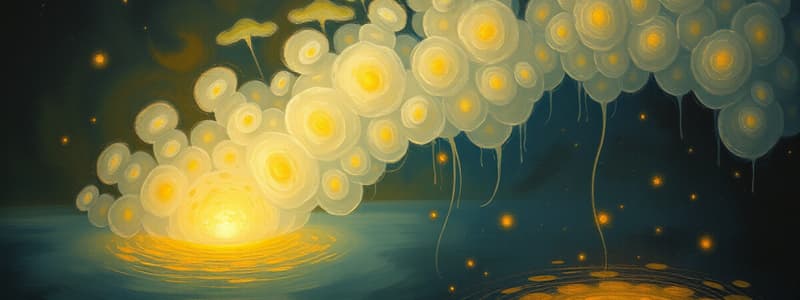Podcast
Questions and Answers
What is a chemotroph?
What is a chemotroph?
An organism that gets energy by breaking down chemical compounds.
What is a phototroph?
What is a phototroph?
Organisms that get their food/energy from light.
What is an example of a chemotroph?
What is an example of a chemotroph?
Tubeworms.
What is an example of a phototroph?
What is an example of a phototroph?
Are phototrophs producers?
Are phototrophs producers?
What is photosynthesis?
What is photosynthesis?
What is chemosynthesis?
What is chemosynthesis?
What is the difference between phototrophs and chemotrophs?
What is the difference between phototrophs and chemotrophs?
Give two examples of living organisms under the water that cannot reach sunlight.
Give two examples of living organisms under the water that cannot reach sunlight.
Give an example of a producer. Why is it a producer?
Give an example of a producer. Why is it a producer?
Give an example of a consumer. Why is it a consumer?
Give an example of a consumer. Why is it a consumer?
Flashcards are hidden until you start studying
Study Notes
Chemotrophs
- Chemotrophs obtain energy by breaking down chemical compounds.
- Example: Tubeworms thrive in deep-sea environments, relying on chemical processes for energy.
Phototrophs
- Phototrophs derive energy from light, primarily through photosynthesis.
- Examples include trees and plants, which are vital for producing oxygen.
Producers vs. Consumers
- Phototrophs are classified as producers as they create their own food and generate oxygen and fruits.
- Producers like trees utilize photosynthesis to convert light, carbon dioxide, and water into glucose.
Photosynthesis
- A unique process exclusive to plants, enabling the conversion of light energy into glucose.
- Involves the intake of light, carbon dioxide, and water to produce energy.
Chemosynthesis
- Some organisms utilize chemical energy instead of light to generate energy-storing carbon-based molecules.
- This process is essential for life forms that exist in environments devoid of sunlight.
Differences Between Phototrophs and Chemotrophs
- Phototrophs harness sunlight to synthesize their own food, contributing to oxygen production and nourishment for other organisms.
- Chemotrophs rely on chemical reactions (such as heat energy) to create food, often sustaining themselves on bacteria found in their environments.
Submerged Life Forms
- Seaweed and algae are examples of organisms in aquatic environments that lack direct access to sunlight, yet still contribute to the ecosystem.
Consumer Example
- The Bald Eagle is classified as a consumer because it cannot produce its own food and relies on consuming other living beings for nourishment.
Studying That Suits You
Use AI to generate personalized quizzes and flashcards to suit your learning preferences.




